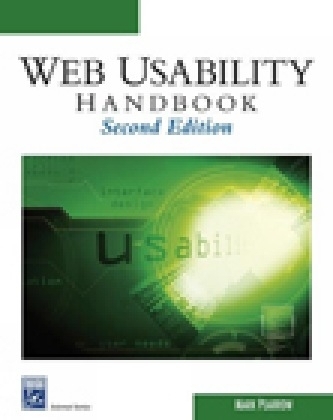
Web Usability Handbook
Seiten
2006
|
2nd Revised edition
Charles River Media (Verlag)
978-1-58450-469-6 (ISBN)
Charles River Media (Verlag)
978-1-58450-469-6 (ISBN)
- Titel ist leider vergriffen;
keine Neuauflage - Artikel merken
Written to teach designers and usability specialists the essential methodologies and tools required to understand user needs, design for them accordingly, and empirically test usability. This edition emphasizes the fact that usability shouldn't be an afterthought, but integrated throughout the entire design and production cycle.
Since the first edition of the Web Site Usability Handbook was published in 2000 there have been numerous changes in the technology world. After the Dot-Com bubble burst, corporate training and education budgets were cut severely and investment in new technology businesses slowed down. But today things have turned around again and behind the scenes at technology companies, usability specialists are still quietly working to make the electronic world easier to manage. This second edition provides the new insights and guidance needed to help make usability an effective and enjoyable journey. Every word from the first edition of this book has been revised, or at least heavily reconsidered; and in many cases, whole sections have been removed or rewritten entirely, while other sections are completely new to this edition. The casual and conversational tone of the fi rst edition has also changed because the current wave of usability specialists embodies a much higher degree of training and knowledge of basic science.
The goals of the book, however, have not changed: to train those concerned with usability how to understand it as one piece of the large technology puzzle that is affecting and shaping the human and natural worlds. Usability is an art and a science, but it is also an obligation we have to society. Accessibility and usability form the foundation of human-enabling technology; that is, technology that serves us, rather than technology that we serve. Everything from understanding the human factors of design and how to generate user-centered designs to accessibility, usability metrics, heuristic evaluation, and testing are detailed. Whether you are a usability professional seeking methods for transforming data into change or a web designer seeking guidance for making your sites easier to navigate, you'll find information and practical tools you can apply to your own sites today.
Since the first edition of the Web Site Usability Handbook was published in 2000 there have been numerous changes in the technology world. After the Dot-Com bubble burst, corporate training and education budgets were cut severely and investment in new technology businesses slowed down. But today things have turned around again and behind the scenes at technology companies, usability specialists are still quietly working to make the electronic world easier to manage. This second edition provides the new insights and guidance needed to help make usability an effective and enjoyable journey. Every word from the first edition of this book has been revised, or at least heavily reconsidered; and in many cases, whole sections have been removed or rewritten entirely, while other sections are completely new to this edition. The casual and conversational tone of the fi rst edition has also changed because the current wave of usability specialists embodies a much higher degree of training and knowledge of basic science.
The goals of the book, however, have not changed: to train those concerned with usability how to understand it as one piece of the large technology puzzle that is affecting and shaping the human and natural worlds. Usability is an art and a science, but it is also an obligation we have to society. Accessibility and usability form the foundation of human-enabling technology; that is, technology that serves us, rather than technology that we serve. Everything from understanding the human factors of design and how to generate user-centered designs to accessibility, usability metrics, heuristic evaluation, and testing are detailed. Whether you are a usability professional seeking methods for transforming data into change or a web designer seeking guidance for making your sites easier to navigate, you'll find information and practical tools you can apply to your own sites today.
Mark Pearrow (Dedham, MA) is a sponsored research staff member at the MIT Computer Science and Artificial Intelligence Laboratory in Cambridge, MA. His current research is in the area of Technology, Psychology, and Society. He is also the author of the first edition of the Web Site Usability Handbook and The Wireless Web Usability Handbook (Charles River Media).
1. Introduction to Usability. 2. Human Factors. 3. User-Centered Design (UCD). 4. Usability Aware Design. 5. Accessibility. 6. Understanding Your Users and Goals. 7. Usability Metrics. 8. Heuristic Evaluation. 9. Usability Testing. 10. GOBANANAS(TM): REAL-TIME MULTIPLAYER GAME. 11. Transforming Data into Change. APPENDIX A: DEVELOPER RESOURCES. APPENDIX B: ABOUT THE CD-ROM. INDEX.
| Erscheint lt. Verlag | 1.11.2006 |
|---|---|
| Zusatzinfo | Illustrations |
| Verlagsort | Hingham |
| Sprache | englisch |
| Maße | 195 x 235 mm |
| Gewicht | 817 g |
| Themenwelt | Mathematik / Informatik ► Informatik ► Netzwerke |
| Informatik ► Software Entwicklung ► User Interfaces (HCI) | |
| Informatik ► Web / Internet ► Web Design / Usability | |
| ISBN-10 | 1-58450-469-2 / 1584504692 |
| ISBN-13 | 978-1-58450-469-6 / 9781584504696 |
| Zustand | Neuware |
| Haben Sie eine Frage zum Produkt? |
Mehr entdecken
aus dem Bereich
aus dem Bereich
Aus- und Weiterbildung nach iSAQB-Standard zum Certified Professional …
Buch | Hardcover (2023)
dpunkt Verlag
CHF 48,85
Lean UX und Design Thinking: Teambasierte Entwicklung …
Buch | Hardcover (2022)
dpunkt (Verlag)
CHF 48,85
Wissensverarbeitung - Neuronale Netze
Buch | Hardcover (2023)
Carl Hanser (Verlag)
CHF 48,95


